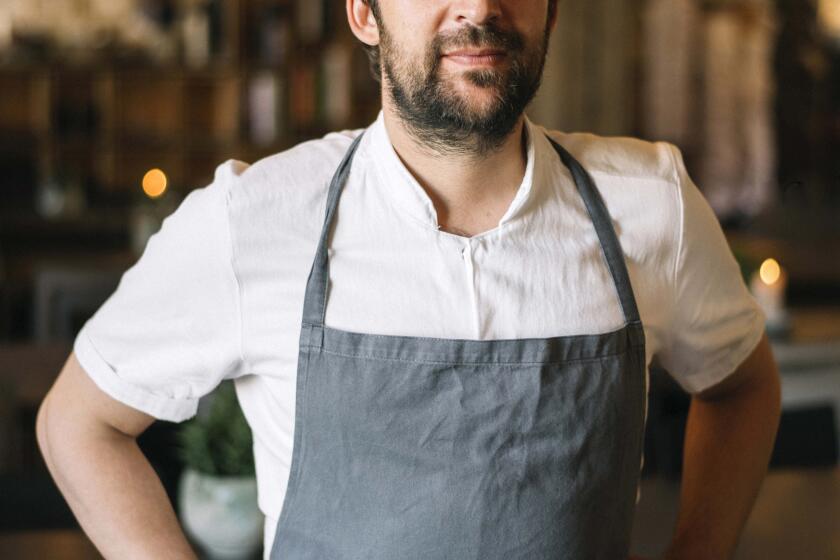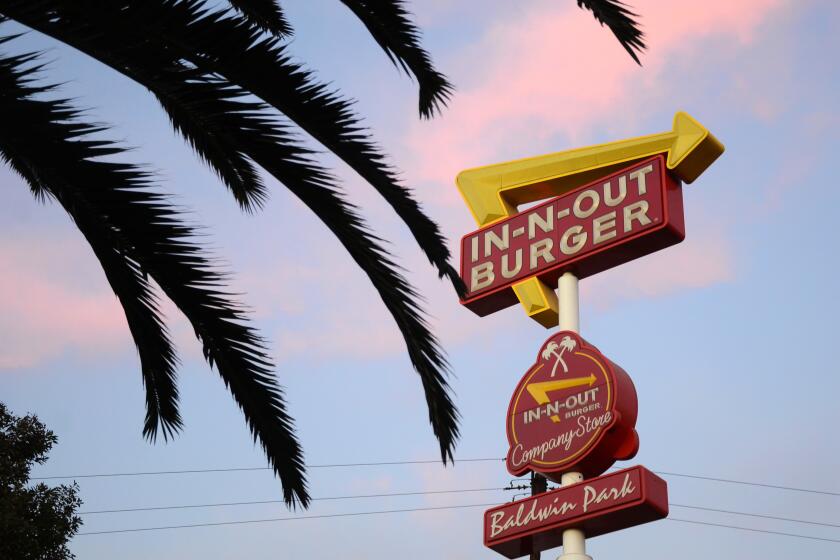
- Share via
Back in the 1980s, the norm-busting adman Jay Chiat liked to pose the question, “How big can we get before we get bad?” as his Los Angeles-based boutique agency attracted clients like Apple and Nike.
It is all too easy, he figured, to do more and accomplish less.
He might as well have been talking about restaurants. For a long time, the industry has embraced replication as the holy grail: If we build it, and then we build a lot more of it, they will come, and we will make lots of money.
But big is no guarantee. Sometimes it fails for reasons that have less to do with the food than with exponential reality — impatient investors, ego battles between the money people and the chef, and the challenge of managing employees owners have never met in cities they rarely visit. Or if all that works just fine, maybe the chef gets cautious about the menu to protect success, and jaded restaurant-chasers move on.
People are standing in line for innovative L.A. ‘bagels.’ The one I tried was plenty good, but it wasn’t chewy and I couldn’t twirl it on my finger.
Restaurants are not financial institutions. There’s no such thing as too big to fail.
Lately, a new generation of restaurateurs has embraced a more modest model, one that harks back to the era before social media and competitive food TV: the old-school one and done; maybe two, but not 10, and not a nationwide restaurant empire.
These independent owner-operators want a career defined by a ZIP Code rather than by cloned outlets and corporate memos, one where they’re on a first-name basis with their customers, their employees and their suppliers. Their notion of success sounds suspiciously, and delightfully, like what it was before a marquee sensibility inflated everyone’s dreams. Owners get real-time gratification. We get just what we need right now — good food with side orders of comfort and connection.
L.A.’s Café Telegrama and Ètra were early arrivals in what’s about to become a colony of little independent restaurants near the intersection of Melrose and Western avenues. Jyan Isaac Bread and its sibling, Ghisallo, have helped turn a block in Santa Monica’s Ocean Park neighborhood into what one regular happily calls “carb alley.” And De La Nonna combines a pizza joint, take-out slice window and a disco bar called the Let’s Go! at the intersection of Little Tokyo, Skid Row and the Arts District. Look around your neighborhood and I expect you’ll find examples of your own.
There’s a reason candidates make stops at local eateries. It’s shorthand for connecting with voters. So who’s the winner when it comes to breaking bread?
To improve their odds, these restaurateurs avoid spaces with destination-dining rents, run multiple operations out of a shared space to decrease downtime and work the room in person. “We gravitated toward small,” said Andrew Lawson, an owner of Café Telegrama and Ètra. “The chef and the partners are on the floor five nights a week, we touch the tables, we know what the regulars like.”
These doubled-up operations improve the odds of what Lawson calls the “crossover customers” who show up for morning coffee, check out the more expensive dinner menu and are inclined to give it a try because they already like the cafe. Jyan Isaac Bread spreads the word with a wholesale operation, generating profits from outlets someone else operates, and De La Nonna has opened an outpost in Big Bear. That’s as big as small gets.
Let’s not kid ourselves; there’s no magic survival formula. The National Restaurant Assn. reports “pent-up demand” across all dining sectors but notes that millennials and Gen Xers prefer to get their food to-go, which puts a crimp in profitable alcohol sales and tips. Here in L.A., restaurants barely caught their breath post-pandemic before fires and the entertainment industry exodus wiped them out, along with their customer base; now the threat of tariffs and higher food costs looms. Business is off from 30% to “empty” in many parts of the city, depending on whom you ask.
Fine dining establishments struggle to survive, and restaurants that lose a Michelin star struggle even more.
And that sorry appraisal predates the arrival this week of ICE and federal troops, which means employees and customers may not be showing up at restaurants at all.
If it seems frivolous to worry about the restaurant business amid everything else that’s going on, think again, because their reach extends far beyond their front doors: Fewer customers means fewer employee shifts, fewer orders for farmers and suppliers, fewer places for you to unwind at the end of a tough day.
That kind of reality check rarely stops someone who’s passionate about feeding people, though. Instead, owners downsize, partner up, work the room, sell their wares wholesale. Small may be the only dream that makes any kind of sense right now.
As for the flip side, I recently conducted an utterly limited and personal investigation on a trip to New York, where the excellent cappuccino at my first stop had morphed into watery coffee topped by something like Styrofoam, and the lunchtime salmon bowl at the second location involved a tired slab of fish retrieved from a warming drawer. And yet both places are so popular they’re opening outlets nationwide — which might be where the focus has shifted to, rather than the food.
Give me little and local anytime.
Contributor: My lonely boycott hasn’t hurt In-N-Out Burger, but our small decisions do add up
California’s favorite fast-food chain hasn’t changed its alignment with anti-vax and anti-LGBTQ politics. That’s not the point.
My first morning back in Santa Monica, I went straight to Jyan Isaac Bread, although I could’ve made coffee at home. Yes, I missed the food; there’s a reason the owner is referred to as the Dough Whisperer. But I also missed the experience: employees who are not cogs in a wheel but individuals with personalities, interests, questions about where I’d been — and answers about what they’d been up to during our communications gap.
When the equivalent experience comes to a vacant storefront near you, count yourself lucky. The big thing now is small: upstart indies that are strategizing to reclaim what a restaurant is supposed to be.
Karen Stabiner’s most recent book is “Generation Chef: Risking It All for a New American Dream.”
More to Read
A cure for the common opinion
Get thought-provoking perspectives with our weekly newsletter.
You may occasionally receive promotional content from the Los Angeles Times.













